Snipers have become the second greatest cause of fatalities in combat in Iraq and Afghanistan. Troops are often most vulnerable in stationary environments, such as when on perimeter or a Forward Operation Base (FOB). Until recently, sniper detection and location systems were employed primarily on vehicular and static installations, when manning guard towers, or out at mobile checkpoints. However, the latest trend in acoustic gunshot detection are the man portable, or wearable systems, introduced at this year’s AUSA 2008 event.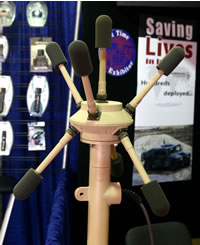
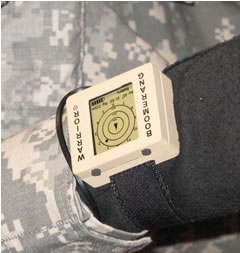 Two versions of gunshot locators were discussed at the AUSA event. Both are being addressed by the US military, in an attempt to improve response effectiveness and reduce vulnerability to attacks by sniper and small arms ambushes. Gunshot locators also improve the warfighter’s situational understanding in emergency situations, particularly when responding to ambush situations.
Two versions of gunshot locators were discussed at the AUSA event. Both are being addressed by the US military, in an attempt to improve response effectiveness and reduce vulnerability to attacks by sniper and small arms ambushes. Gunshot locators also improve the warfighter’s situational understanding in emergency situations, particularly when responding to ambush situations.
The Boomerang acoustic shooter detection system was developed by BBN to provide warning over sniper threats. Today, over 1,000 Boomerang systems are operational worldwide and procurement of 8,000 additional systems is currently underway. Initially, the system was installed on vehicles, but the most recent enhancements, a static installation kit and portable system, complements the Boomerang to cover more modes of operation.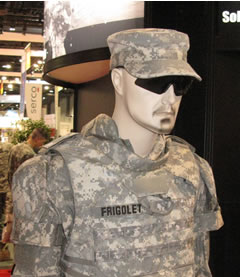
Boomerang automatically provides immediate indication of hostile fire or sniper attacks and localizes the shooter’s position, allowing rapid, informed and coordinated response. The system can be installed on an individual vehicle (manned or unmanned), at a checkpoint, or be scaled up for full perimeter security of a forward operating base. The ability to identify insurgent firing locations quickly eliminates random patrol deployments and exposure to unknown hostile fire.
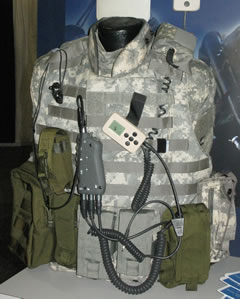 The static installation kit is contained in a man-portable package, providing rapid installation in temporary or fixed sites. It is equipped with interfacing, to enable interoperability with remote weapon stations and EO/IR sensors currently fielded in theater. Furthermore, several Boomerang sensors can be integrated and networked, to provide better and more precise coverage of fixed sites. Gunshot alerts can be integrated and presented into situational awareness pictures, such as the Blue Force Tracking or FBCB2.
The static installation kit is contained in a man-portable package, providing rapid installation in temporary or fixed sites. It is equipped with interfacing, to enable interoperability with remote weapon stations and EO/IR sensors currently fielded in theater. Furthermore, several Boomerang sensors can be integrated and networked, to provide better and more precise coverage of fixed sites. Gunshot alerts can be integrated and presented into situational awareness pictures, such as the Blue Force Tracking or FBCB2.
A parallel development known as “Warfighter Wearable Gunshot & Sniper Detection” is currently pursued. QinetiQ North America is maturing under a $10 million order, awarded by the U.S. Army Rapid Equipping Force (REF). QinetiQ announced the system (known as EARS) at the AUSA Winter event this year, which has now been endorsed by the U.S. Army and is expected to be deployed with U.S. warfighters in Iraq and Afghanistan this year.
The deployment of the systems is expected to be completed by early 2009. The one pound wearable EARS Gunshot Localization System employs the EARS-150 palm-sized 6.4 ounce ‘Man-Mounted’ sensor, placed on the soldier’s shoulder. A single sensor covers 360 degrees and will accurately locate snipers within less than a second, after firing a single shot, when the soldier is standing, walking or moving in a vehicle.
BBN Technologies recently announced receiving an award of $3.5 million from the U.S. Army to develop an even more compact soldier wearable shooter detection system, in partnership with the U.S. Army Natik Soldier Research, Development and Engineering Center. The wearable system will operate in ‘stand-alone’ and networked environments, providing individual soldiers with immediate awareness of hostile fire locations. Networked systems are providing unit leaders with the situational awareness needed to coordinate response to hostile fire. The Boomerang Warrior-wearable shooter detection system uses acoustic sensors embedded in the soldier’s shoulder pads, earpiece providing audible warning announcement and wrist wearable display presenting the threat’s relative direction, distance and elevation. The soldier’s position and hand movements are compensated by the display to provide consistent, accurate bearing to the target.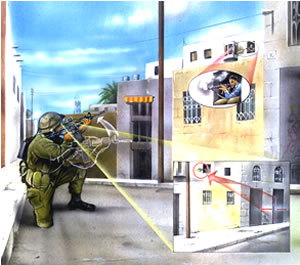
Acoustic processing is not the only solution for gunshot detection. Gunshot signature can be identified, located and processed even faster using eletcro-optical means. Two Israeli systems are providing such capabilities – Rafael’s Spotlite M and IAI/Elta’s Short-Wave Infrared (SWIR) are sensors-based and a Transient Event Detection (TED) system, developed by a new subsidiary called OptigO. They are designed to cover a wide area, triggering a instant alarm and threat location when a single shot is fired.
















